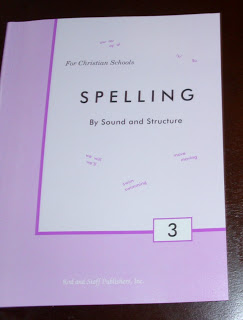This is no longer available, but if you are still interested in a phonics- or spelling-style lapbook, other resources we used for the lapbook were from Barbara Blakey’s Twenty-Six Common Spelling Rules and All About Spelling’s 20 Best Tips for Teaching Spelling. (As a side note, I’ve heard great things about All About Spelling, but it is a program we have not used.) Another good resource is McGuffey’s Eclectic Spelling Book by William Holmes McGuffey, free from Gutenberg.org. And to practice spelling words on-line, http://www.spellingcity.com/ is one of the boys’ favorites. Here you can practice, play games, and test spelling lists that you input yourself. (This is also a good site for practicing geography as well.)
We’ve been using a variety of resources for language arts this year, so it follows that we also have used a few different programs for spelling. As I mentioned in a previous post, the spelling lists in Total Language Plus are from the work of literature being studied, so they were not grouped by rules. Therefore, we decided to use Spelling Power by Beverly L. Adams-Gordon, a book that can be used from age 8 through high school. The version we have contains a CD-ROM with printables and spelling activities, though there is also an activity task box available for purchase as well. Because this book had so much information in it, I was glad it contained a shortcut DVD version of how to use the program. The DVD definitely helped us to start using the program quickly.
The book contains spelling lists grouped according to rule and age/grade level, with review of previous words interspersed throughout. The 15-minute daily spelling routine is to complete a Daily Test (with rule written at the top), a 10-Step Study Sheet for any words missed, and a fun spelling activity based upon the activity cards. The student does not study words until AFTER the test, so the student is studying only the words he/she does not know how to spell. The 10-Step Study Sheet is completed for missed words, and then the words missed are added to the beginning of the next daily test to see if he/she has retained how to spell the word correctly.
The only tests scored are the Delayed Recall Tests. The End of Level Tests should be passed with 100% accuracy before moving to the next grade level in the spelling lists.
The benefits of this program are that it is a complete program including mastery of the top 5,000 most frequently used words, the student only studies the words he/she does not know, and it has many hands-on activities for the student. Stephen enjoyed writing his words outside with chalk and on the board in our schoolroom. (I always enjoy finding the little messages written when he’s doing something like this…)
Some drawbacks of Spelling Power is that it does not include worksheet activities that some children (like Stephen) enjoy, and it also can be frustrating for the perfectionist, as you don’t get a chance to study the words before you take the test. So, if your child likes to get everything right the first time, it may prove to be a challenge getting this program up and running. At Stephen’s request, we moved on to Rod & Staff Spelling 3. He loves all of the worksheet activities (like listing the rhyming words, for instance), so we will continue with this until the end of the school year.
Of course, we can’t seem to do anything without creating a lapbook, so we completed Homeschoolshare’s Spelling & Phonics Rules Lapbook (which has since been removed from HSS) to capture many of the spelling rules. However, I had to modify some of the rules that are listed in this lapbook – mainly to include the word “usually” in the rules.
We will likely return to Spelling Power again in the future. We just need to incorporate more of the fun activities into it by making spelling tiles and performing some of the other suggested activities.
By the way, did I misspell anything here? Time to run spellcheck to find out!









